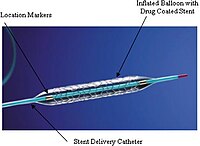
Photo from wikipedia
The branches of the porcine subclavian artery are frequently used in endovascular stroke training and research. This study aimed to determine a porcine weight group, in which the arterial diameters… Click to show full abstract
The branches of the porcine subclavian artery are frequently used in endovascular stroke training and research. This study aimed to determine a porcine weight group, in which the arterial diameters most closely match human cerebral artery diameters, and thus optimize the porcine in-vivo model for neuroendovascular purposes. A group of 42 German Landrace swine (45–74 kg) was divided into four subgroups according to their weight. Angiographic images of the swine were used to determine the arterial diameter of the main branches of the subclavian artery: axillary artery, brachial artery, external thoracic artery, subscapular artery (at two different segments), suprascapular artery, caudal circumflex humeral artery, thoracodorsal artery, and circumflex scapular artery. The porcine arterial diameters were correlated with animal weight and compared to luminal diameters of human arteries which are commonly involved in stroke: internal carotid artery, basilar artery, vertebral artery, middle cerebral artery and M2 branches of the middle cerebral artery. Swine weight was positively correlated with porcine arterial diameter. The most conformity with human arterial diameters was found within the two heavier porcine groups (55–74 kg). We suggest the use of swine with a weight between 55–59.7 kg, as lighter animals show less similarity with human arterial diameters and heavier animals could cause more problems with manipulation and handling.
Journal Title: PLoS ONE
Year Published: 2022
Link to full text (if available)
Share on Social Media: Sign Up to like & get
recommendations!